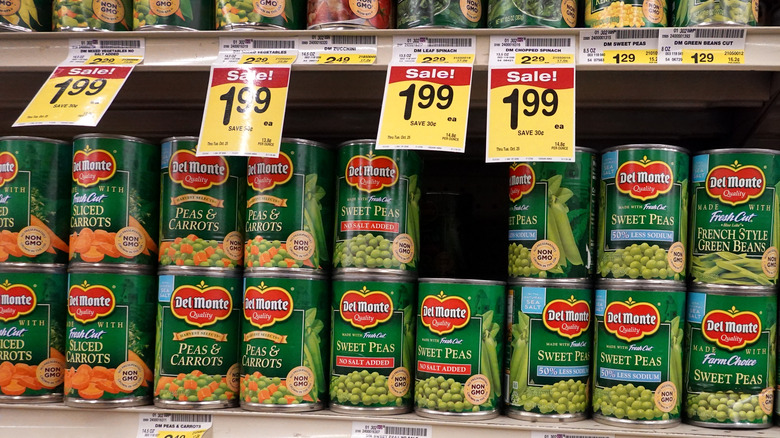The Red Flag To Avoid When Buying Canned Veggies
If someone told you that canned vegetables aren't as nutritious as fresh vegetables, forget what you think you know. Canned vegetables are the same vegetables that get picked and packaged as fresh and frozen, they're just processed at a canning facility to preserve their shelf life. Fresh, frozen, and canned vegetables are all viable — and tasty — options for getting extra fiber and vitamins on your plate. The one red flag to avoid when you're shopping for canned vegetables, however, is added salt.
Canned vegetables can get a bad rap, but they're actually chock full of nutrients like any other piece of produce. In fact, since most canned veggies are processed within days of harvest, their vitamins and minerals are locked in. It's not uncommon to find canned produce with added salt, however, which food companies use to enhance flavor and texture. Extra salt in a can of vegetables is not necessarily harmful, because we do need some sodium in our diets to survive, but it will certainly change the taste of your ingredients and affect how much salt you'll need to add to a dish. It's also something to look out for if you're following a low sodium diet. Thankfully it's super easy to figure out which cans have added salt. All you need to do is understand how to read a nutrition label.
Read can labels carefully
If you're in the supermarket to grab a can of corn for chowder, make sure you know exactly what you're buying before you toss anything in the cart. Many canned foods are full of sodium. Remember that it's always much easier to salt food as you're cooking to build flavor than it is to correct something that's too salty at the end. Opt for starting with plain, unsalted canned vegetables if you're making a recipe. A can of San Marzanos with added salt can make a huge difference in a batch of homemade tomato sauce, for example, so make sure you read your nutrient labels carefully.
In the United States, all processed food is required by law to have a nutrition label on the package (per the FDA). Most food companies like to make health-related claims on the front of the package, so many cans will say "low salt" or "no sodium added," but not always. To be totally sure, flip the can over and read the sodium content in the label. Most vegetables are very low in sodium, so if you see any numbers higher than 5 or 10 milligrams, there's probably added salt. If you're not sure what you're looking at, take a few minutes to learn how to read nutrition labels.
Rinse canned vegetables to cut down on the salt
If you've already bought canned vegetables without reading the labels, and it's time to make a black bean dip with cilantro, don't stress. Even though some canned vegetables have salt added, they're perfectly safe to eat unless your doctor has advised you to follow a low sodium diet. The only issue is that the food will actually taste saltier, so you'll need to adjust the salt in your recipe so that it comes out balanced and tasty.
If you have canned veggies with added salt, you can also give them a quick rinse under the tap to wash off some of the brine. Just pour the veggies into a wire strainer or colander and give 'em a wash, which can reduce anywhere from 25 to 40% of the sodium according to multiple studies (per the Washington Post).
Even if you're not one of the folks who needs to watch out for sodium in their diet, it's still smart to keep a lookout for hidden salt. The American Heart Association says that as much as 70% of all the salt we eat comes from prepared foods, so keep an eye on any food labels and try not to exceed the U.S. recommended daily value given by the FDA of 2,300 milligrams — which is only about 1 teaspoon of table salt per day. Unsalted canned vegetables taste perfectly fine, and you can always season them to your liking once you open the can.


